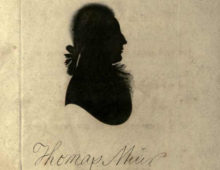Tagged with Travel
Resource : Scrimshaw Whale Tooth Engraving
‘Death to the living, long life to the killers / Success to the sailors wives & greasy luck to whalers’
Resource : Locomotion No. 1
This is the first steam powered railway engine to run on a public railway. It was designed by George Stephenson and sparked a transport revolution that transformed the lives and fortunes of people across Britain and the wider world.
Resource : George Stubbs’ ‘The Kongouro from New Holland’ (Kangaroo)
This is a painting of an Australian kangaroo by the artist George Stubbs. This was the first time people in Britain had seen such a creature.
Resource : Launch of the Great Britain Steamship,1843. Lithograph of a painting by Joseph Walter
Isambard Kingdom Brunel’s SS Great Britain is one of Britain’s most important ships. By combining size, power and innovative technology, Brunel revolutionised sea travel and paved the way for modern ship design.
Resource : The Velocipede
Invented 200 years ago, the humble bicycle is one of the most popular and enduring innovations of all time. Relatively cheap and simple to produce, environmentally sound, easy and fun to use, great for keeping fit and available to people of all ages and from all walks of life, it is still a significant part of our lives today.
Resource : Train ticket: Liverpool to Warrington
The advent of steam hauled railways in the 1820s quickly revolutionised passenger travel and the transport of goods across Britain and the wider world. This is an early train ticket for a journey from Liverpool to Warrington.
Resource : Tollhouse designed by Thomas Telford
Throughout the 1700s, the turnpike system spread throughout Britain, charging travellers a toll (fee) at different points along its roads to pay for maintenance and improvement. This tollhouse is in Oborne, Dorset. Often situated in isolated areas of the country, the toll collectors needed a good view from these houses in case of attack from thieves or protestors.
Resource : John McAdam’s snuff box
John McAdam revolutionised road travel in the 1800s, through his ‘Macadamisation’ method. The greatest advance in road construction since Roman times, his principles are still applied to road building today.
Resource : Passport Signed by the Duke of Wellington
Travelling in Europe was very popular among the British nobility, gentry, and professionals of the 1700s and 1800s. It became traditional for upper class men and women to embark on a lengthy ‘Grand Tour’ of Europe, where they would experience the languages and history of the continent while showing off their own status and wealth. It was also popular with British artists, writers and thinkers of the time, keen to broaden their experience and exchange ideas – particularly with their counterparts and the new celebrities and centres thrown up by the upheavals of revolution.
Resource : Invention of the lifeboat, Willie Wouldhave, South Shields, 1789
In 1789, a coal ship named Adventure ran aground at the mouth of the River Tyne during a violent storm. The sea was too rough for the local boats and nothing could be done to save the thirteen-man crew. This tragic loss prompted a competition to design a new type of boat, that could carry 24 people and was suitable for rescues in rough and stormy seas. The result was the first ‘Life-Boat’.


